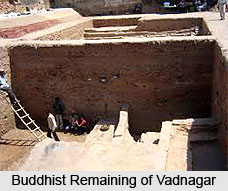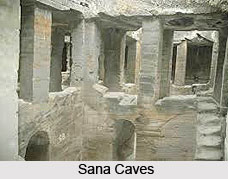 Buddhism in Gujarat emerged during the time of Ashoka and later the Buddhism is patroned by many regional feudal lords of early phase of history of Gujarat. For this reason, there are many caves, ancient relics and the monasteries constructed from the time of Mauryans to Satavahana (Satavahana Dynasty) eras.
Buddhism in Gujarat emerged during the time of Ashoka and later the Buddhism is patroned by many regional feudal lords of early phase of history of Gujarat. For this reason, there are many caves, ancient relics and the monasteries constructed from the time of Mauryans to Satavahana (Satavahana Dynasty) eras.
Buddhism a moderate wing from Hinduism was introduced by Gautama Buddha. Buddhism has spread all over India and is regarded as one of the three most widespread major world religions. Buddhism came into Gujarat with the hands of wanderings of Gautama Buddha or Shakyamuni or Gautama, in 5th or the 6th Centuries B.C.
The myriad monuments and writings or scriptures found in Gujarat stand as a time silent testimony of the resilience of the ear and the values which Buddha stood for. Some of the caves and monasteries in Gujarat are Uperkot Caves, Khapra Kodiya Caves, Baba Pyare Caves, Junagadh Buddhist Cave Groups, Sana Cave, Vadnagar, Devni Mori, Kadia Dungar Caves, Vallabhi, Khabhalida cave, Sana Cave, Bhavnagar and Talaja Caves.
Sana Cave
Sana Cave in the hill full of caves scattered at different levels. The most interesting group of Sana Cave, is the cave full of ornate carvings and stupas, rock cut pillows, benches and chaityas. Some caves also have a dome and pillared hall. Sana Caves are among the few earliest caves of Western India, dating from 2nd century BC. Buddhism grew strong roots in Gujarat by 270 BC during the spectacular rule of King Ashoka. This is portrayed in scriptures found in Sana Caves. The ancient travelogues of Hiuen Tsiang and I-Tsing contain accounts of it. It was much more than a religion, since, it was a way of life, and a living style in that era. On its most part, Buddhism was carried to this Western part through traders who frequented their caravan up to distant regions. Even at that time, Gujarat had given an excellent and ready response to the great teaching of Buddha.
Buddha Remains in Vadnagar
In Gujarat, many territories got blessed by the spirit of Gautama Buddha and venerated by followers of Buddhism and assiduously studied by historians and archaeologists, these were once thriving inhabitations of Buddhists and contained some of the holiest monasteries. Vadnagar is an ancient city in Gujarat. Its known from the history that goes back to 2,500 B.C. The archaeological excavations have established that the settlement of mainly agricultural community existed in the place more than 4,500 years back. The pottery, textiles fragments, ornaments, tools, etc., were found during these excavations from various sites around the present lake Sharmishtha. Some archaeologists suggest that it was one of the many Harappan sites. Later this city was flourished from the time of Gautama Buddha. The early settlement was on the bank of Kapila river flowing from the hills of Aravalli. It fed water to a lake, known as Sharmishtha, at the site and the settlement extended around it. Over a period of time the settlement grew into a city of considerable size.
Devni Mori
Devni Mori is one of the most popular archaeological sites in Gujarat, where one can find the architectural remaining containing the ideas and teachings of Gautama Buddha. The remains at Devni Mori are situated in a picturesque valley on the bank of the river Meshvo near Shamlaji, where the river enters the plains of North Gujarat after cutting through the mountain range of Aravalli Range.
 As a result of excavations from 1960 to 1963, the site has yielded a towering Saririka stupa, which is known as Mahastupa in the inscription of the casket found within the core, two monasteries, four votive stupas, an apsidal temple, a rectangular structure and a protecting wall. The lofty stupa, with the upper portion missing, rests on two square platforms rising in diminishing tiers, the lower one being nearly 86 ft. square and 7 ft. 10 inches in height and upper one about 70 ft. square.
As a result of excavations from 1960 to 1963, the site has yielded a towering Saririka stupa, which is known as Mahastupa in the inscription of the casket found within the core, two monasteries, four votive stupas, an apsidal temple, a rectangular structure and a protecting wall. The lofty stupa, with the upper portion missing, rests on two square platforms rising in diminishing tiers, the lower one being nearly 86 ft. square and 7 ft. 10 inches in height and upper one about 70 ft. square.
Kadia Dungar Caves
In Kadia Dungar Caves, there are seven rock cut caves mirroring the preaching of Gautama Buddha. There is a set of three broad mouldings of which the central one is a torus. Likewise, there are mouldings above the pilasters, but they are arranged corbelwise. In about 6th century A.D., the stupa underwent minor repairs. A dam was constructed on the river Meshvo in 1964 due to which the site was submerged under water. Before the construction of the dam, the remains were taken to a museum in the city of Baroda (modern Vadodora).
Vallabhi
Vallabhi in Gujarat is one of the most frequented cultural centres of Buddhism during 6th to 8th centuries AD. An extensive congregation of Buddhists monks and nuns of the Hinayana and Mahayana Schools originated from here. The ancient Chinese traveller, I-Tsing compared Vallabhi with Nalanda, another ancient university in ancient times and from his account; it would appear that the courses of study at both the universities were more or less identical.
Junagadh Caves
The Buddhist cave group of Junagadh contain inscriptions of three dynasties which speak of the great popular faith and its healing power to convert the King. Uperkot caves are in the old fort of Junagadh. Buddhist caves here are known as the two-storied hall. The Buddhist caves here are interesting both on account of their plan and also for the decorative motives and sculptures. The two storey hall consists of a water tank which is connected to a chamber which has four pillars arranged in a square and three more pillars at the northern end. The rock above the four pillars has been cut away.
Khambhalida Caves
Khambhalida Caves are located in Rajkot district of Gujarat near Gondal. The group of Khambhalida Caves has three caves containing Chaitya and Stupa. The Chaitya gate includes figures of Bodhisattva Padmapani and Vajrapani on right and left respectively. The caves were carved in 4th-5th century AD in the limestone rock. The recessed benches of Khambhalida Caves have been cut around the three sides of the hall, above which is a freeze decorated with lattice and Chaitya symbols. The capitals of all the pillars are carved with animals. In these caves, certain religious symbols, identified as Svastika, Bhadrasana, Nandipada, Mina-yugala and Kalasa were found. There is another group of Buddhist caves on the eastern side of the town of Junagadh near Bava-Pyara Matha or Baba Payara Cave. They are arranged in three rows. It houses what is considered the prototype for the typically Buddhist Chaitya arch ornamentation.
Bhavnagar Caves
There are 36 caves perched at different heights of a single isolated picturesque hill, situated near the confluence of the Shatrunji and Talaji in Bhavnagar. The caves of Bhavnagar located in Bhavnagar District of Gujarat have little architectural merit. They usually consist of a few cells at the back of a pillared verandah, though a typical rock-cut quadrangular monastery also exists. The archaeologists of Archaeological Survey of India believe that there are many more caves lying buried under the hillock.



















